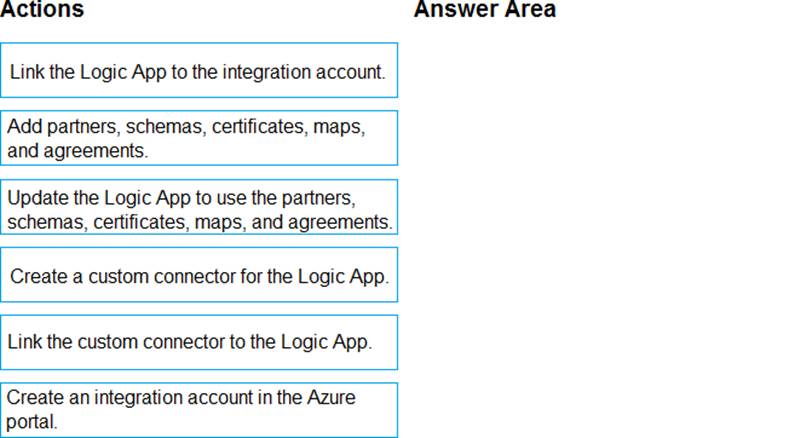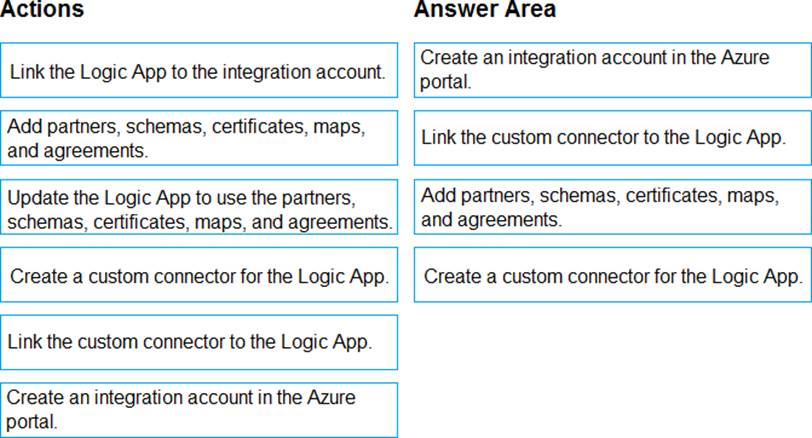- All Exams Instant Download
Which four actions should you perform in sequence?
Case Study 1
Current environment
Windows Server 2016 virtual machine
The virtual machine (VM) runs BizTalk Server 2016.
The VM runs the following workflows:
– Ocean Transport C This workflow gathers and validates container information including container contents and arrival notices at various shipping ports.
– Inland Transport C This workflow gathers and validates trucking information including fuel usage, number of stops, and routes.
The VM supports the following REST API calls:
– Container API C This API provides container information including weight, contents, and other attributes.
– Location API C This API provides location information regarding shipping ports of call and tracking stops.
– Shipping REST API C This API provides shipping information for use and display on the shipping website.
Shipping Data
The application uses MongoDB JSON document storage database for all container and transport information.
Shipping Web Site
The site displays shipping container tracking information and container contents. The site is located at http://shipping.wideworldimporters.com/
Proposed solution
The on-premises shipping application must be moved to Azure. The VM has been migrated to a new Standard_D16s_v3 Azure VM by using Azure Site Recovery and must remain running in Azure to complete the BizTalk component migrations. You create a Standard_D16s_v3 Azure VM to host BizTalk Server.
The Azure architecture diagram for the proposed solution is shown below:

Requirements
Shipping Logic app
The Shipping Logic app must meet the following requirements:
– Support the ocean transport and inland transport workflows by using a Logic App.
– Support industry-standard protocol X12 message format for various messages including vessel content details and arrival notices.
– Secure resources to the corporate VNet and use dedicated storage resources with a fixed costing model.
– Maintain on-premises connectivity to support legacy applications and final BizTalk migrations.
Shipping Function app
Implement secure function endpoints by using app-level security and include Azure Active Directory (Azure AD).
REST APIs
The REST API’s that support the solution must meet the following requirements:
– Secure resources to the corporate VNet.
– Allow deployment to a testing location within Azure while not incurring additional costs.
– Automatically scale to double capacity during peak shipping times while not causing application downtime.
– Minimize costs when selecting an Azure payment model.
Shipping data
Data migration from on-premises to Azure must minimize costs and downtime.
Shipping website
Use Azure Content Delivery Network (CDN) and ensure maximum performance for dynamic content while minimizing latency and costs.
Issues
Windows Server 2016 VM
The VM shows high network latency, jitter, and high CPU utilization. The VM is critical and has not been backed up in the past. The VM must enable a quick restore from a 7-day snapshot to include in-place restore of disks in case of failure.
Shipping website and REST APIs
The following error message displays while you are testing the website:
Failed to load http://test-shippingapi.wideworldimporters.com/: No ‘Access-Control-Allow-Origin’ header is present on the requested resource. Origin ‘http://test.wideworldimporters.com/’ is therefore not allowed access.
Drag and Drop Question
You need to support the message processing for the ocean transport workflow.
Which four actions should you perform in sequence? To answer, move the appropriate actions from the list of actions to the answer area and arrange them in the correct order.

Answer: 
Explanation:
Step 1: Create an integration account in the Azure portal
You can define custom metadata for artifacts in integration accounts and get that metadata during runtime for your logic app to use. For example, you can provide metadata for artifacts, such as partners, agreements, schemas, and maps – all store metadata using key-value pairs.
Step 2: Link the Logic App to the integration account
A logic app that’s linked to the integration account and artifact metadata you want to use.
Step 3: Add partners, schemas, certificates, maps, and agreements
Step 4: Create a custom connector for the Logic App.
Reference: https://docs.microsoft.com/bs-latn-ba/azure/logic-apps/logic-apps-enterprise-integration-metadata
Latest AZ-204 Dumps Valid Version with 254 Q&As
Latest And Valid Q&A | Instant Download | Once Fail, Full Refund
Subscribe
Login
0 Comments
Inline Feedbacks
View all comments

